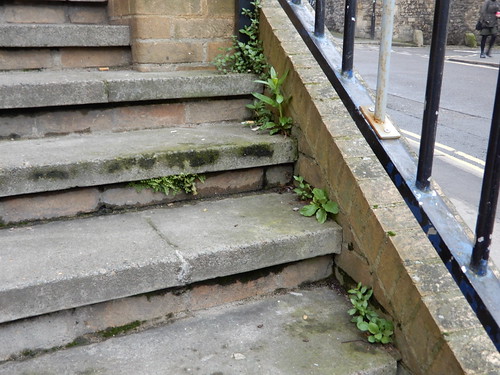This idea came to me over the summer, as I was hauling three hazel saplings and a sucker ash out of my herb pots. Why do we plant plant pots? I mean, obviously I popped a Loropetalum Chinensis Ever Red into one of my pots (and watched it die in a terrible withering cold spell) because I thought it was beautiful and wanted it, my precious, but if all you're after is a fringe of cheery greenery, why'd you bother planting up the pot? Why not just leave it for come-what-may?
This harks back to Hundertwasser's principle of Portions, with a third of horizontal surfaces private, held for gardens of dwellings, a third public and planted, with respect to the obligation to have trees, and a third reserved for "spontaneous vegetation".
Spontaneous vegetation is of course a dirty word. Allow me to quote Jana VanderGoot from Architecture and the Forest Aesthetic:
But what if there were deep planters which included reserved space for spontaneous seedlings? What if we didn't weed out the volunteers and write-ins, the fly-throughs and random arrivals, from the planters until they began to spread beyond their allocated third?
Well, I have a few containers of every size in my garden that I've not got around to putting anything successful in, or which have a thing which has died, or which have been invaded by cheerful weeds, and I have become accustomed to it. The mature hapsadaisical pots have started sprouting spontaneous trees, Bog Myrtle in the water pots, Dogwood in the dry pots, Ash in the stony pots and Hazel absolutely everywhere. I've got used to them, with their cheerful flags of Red Valerian, Marguerite, Columbine, Willowherb and Bindweed. I'd miss them if they weren't there (though that is just as true of all my fancies and tenders and pretties of course). But never mind rewilding; this is reweeding.
So, what do we need to get from here to there?
I love this idea because it has a bewitching simplicity. In some sense you could achieve quite a lot with just a few signs saying things like "Reweeding Area" or "Spontaneous Vegetation Space" or "Fallow Area - Please Leave" and whatever happens to be closed, neglected, in-between plantings, abandoned or awaiting agreement that week in your urban area.
Of course defending that space for the weeds would be rather more of a challenge.
This harks back to Hundertwasser's principle of Portions, with a third of horizontal surfaces private, held for gardens of dwellings, a third public and planted, with respect to the obligation to have trees, and a third reserved for "spontaneous vegetation".
Spontaneous vegetation is of course a dirty word. Allow me to quote Jana VanderGoot from Architecture and the Forest Aesthetic:
The phrase spontaneous vegetation tends to be used synonymously with words like weedy, invasive or unkempt when it appears in discussions of aesthetics and architectural space. Spontaneous vegetation often signals the social failure of unsafe, chaotic and isolated places. It is also associated with the economic failure of abandoned lots and run-down buildings in need of maintenance.This conjures spectres of the dried planters outside closed bars dribbling rosebay willowherb and sow thistle (not usually a problem) and of willow and buddleia sprouting from cracked architraves and damaged drains (you need to weed your frontage as a matter of urgency), and other things like that which sooner or later get tidied up.
But what if there were deep planters which included reserved space for spontaneous seedlings? What if we didn't weed out the volunteers and write-ins, the fly-throughs and random arrivals, from the planters until they began to spread beyond their allocated third?
Well, I have a few containers of every size in my garden that I've not got around to putting anything successful in, or which have a thing which has died, or which have been invaded by cheerful weeds, and I have become accustomed to it. The mature hapsadaisical pots have started sprouting spontaneous trees, Bog Myrtle in the water pots, Dogwood in the dry pots, Ash in the stony pots and Hazel absolutely everywhere. I've got used to them, with their cheerful flags of Red Valerian, Marguerite, Columbine, Willowherb and Bindweed. I'd miss them if they weren't there (though that is just as true of all my fancies and tenders and pretties of course). But never mind rewilding; this is reweeding.
So, what do we need to get from here to there?
- A greater tolerance of bare soil or fluctuations of greenery levels. An indulgent tolerance of the browns and greys of winter and early spring.
- A range of pots with concealed water reservoirs in their bases available for every size and position, and easy availability of cheap municipal planting mix to fill them with..
- A shift to a positive language and attitude when discussing weeds, vegetation and spontaneous growers. I've started that a little here, with the concepts of reweeding, come-what-may and volunteer plants.
- A higher tolerance of green spread from containers, allowing tumble and scatter of vigorous plants a little allocated space around their containers.
- The boldness to step back and allow vegetation to happen.
I love this idea because it has a bewitching simplicity. In some sense you could achieve quite a lot with just a few signs saying things like "Reweeding Area" or "Spontaneous Vegetation Space" or "Fallow Area - Please Leave" and whatever happens to be closed, neglected, in-between plantings, abandoned or awaiting agreement that week in your urban area.
Of course defending that space for the weeds would be rather more of a challenge.



No comments:
Post a Comment